Italeri's 1/72 Leopard 1A2
|
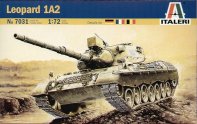 |
Leopard 1A2
The Leopard Project started in
November 1956 in order to develop a modern tank to replace the Bundeswehr's
M-47 and M-48 which were rapidly becoming outdated. The new Design needed
to be able to withstand 20mm antitank guns, and operate in a battlefield
contaminated with chemical weapons and radioactive fallout. In addition
the main armament was to be upgraded to the British L7A3 105mm gun and
carry as much ammunition as current American designs.
West Germany and the French Fourth Republic signed an agreement to design
a common tank. Eventually France left the agreement and went to develop
its own AMX-30. The first Batch left the production facilities in 1965.
The Leopard 1 was being purchased by a number of NATO countries including
Norway, Denmark, Turkey, Greece, Italy Canada, Belgium as well as Australia.
The first 232 tanks of the 5th production batch were delivered as Leopard
1A2 between 1972 and 1974. The A2 included a heavier and better armored
turret, and therefore did not receive the B&V armor add-ons as did
earlier machines. They did receive the other upgrades however-The Leopard
A2A1 received the PZB200, the A2A2 SEM 80/90 all digital radios and the
A2A3 got both. The Leopard 1 was eventually succeeded by Leopard 2. Variants
of the Leopard 1 design included Antiaircraft tanks, Bridge layers, pioneer-and
recovery vehicles. A total of 3600 Leopard 1 were built.
The Kit
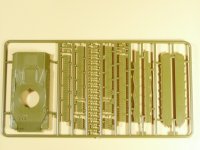 This
kit comes in an open-end box depicting an Italian tank. On the back are
pint instructions for a German, an Italian and a Belgium tank. The paint
instructions refer to Model Master acrylic paints. A description of the
tank is printed in 6 languages on the side of the box as well as in the
instruction sheet. Decals for 2 Italian, 1 Belgium and 1 German Tank are
included. The kit has 3 olive drab sprues with a total of 123 parts. The
parts appear clean with little flash and sink marks. The inceptor pin
marks will be hidden after assembly. The overall detail is good, except
for the tracks and the road wheels. While the running surface of the link-and-length
tracks looks decent, there are no guide horns and the road wheels are
made in one piece each, looking more like Formula 1 car tires then tank
road wheels. The molded on pioneer tools appear too large for This
kit comes in an open-end box depicting an Italian tank. On the back are
pint instructions for a German, an Italian and a Belgium tank. The paint
instructions refer to Model Master acrylic paints. A description of the
tank is printed in 6 languages on the side of the box as well as in the
instruction sheet. Decals for 2 Italian, 1 Belgium and 1 German Tank are
included. The kit has 3 olive drab sprues with a total of 123 parts. The
parts appear clean with little flash and sink marks. The inceptor pin
marks will be hidden after assembly. The overall detail is good, except
for the tracks and the road wheels. While the running surface of the link-and-length
tracks looks decent, there are no guide horns and the road wheels are
made in one piece each, looking more like Formula 1 car tires then tank
road wheels. The molded on pioneer tools appear too large for 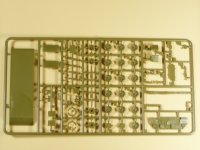 this
scale. The MG3 AAMG also doesn't look right. The 9 step instruction sheet
contains a parts map, a paint chart for Model Master acrylics as well
as paint instructions for 4 tanks. The first 5 assembly steps cover the
assembly of the suspension, link and length tracks as well as the lower
hull. Everything is straight forward. Steps 6 and 7 cover the assembly
of the turret with the option of adding the IR search light and gunfire
simulator. The one piece gun barrel looks right and has only a small mold
seam. The upper hull is assembled in step 8. No surprise there. The final
assembly of upper and lower as well as the turret happens in step 9. Then
you will be given the option to add armor side skirts. this
scale. The MG3 AAMG also doesn't look right. The 9 step instruction sheet
contains a parts map, a paint chart for Model Master acrylics as well
as paint instructions for 4 tanks. The first 5 assembly steps cover the
assembly of the suspension, link and length tracks as well as the lower
hull. Everything is straight forward. Steps 6 and 7 cover the assembly
of the turret with the option of adding the IR search light and gunfire
simulator. The one piece gun barrel looks right and has only a small mold
seam. The upper hull is assembled in step 8. No surprise there. The final
assembly of upper and lower as well as the turret happens in step 9. Then
you will be given the option to add armor side skirts.
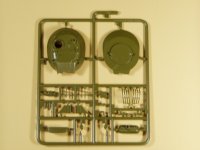 |
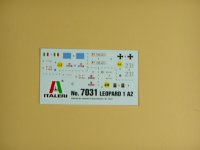 |
Conclusion
This is definitely an interesting and welcome subject of one of the
most successful post WW2 tank designs. Unfortunately the lack of detail
on the tracks and suspension lets this kit fall into mediocrity compared
to kits from other manufacturers. I would have expected more from a kit
from such a renowned company as Italeri. But for modelers of small scale
modern armor this is for sure a must have kit. I would like to thank Testor's
for the review kit.
References
|
|

 This
kit comes in an open-end box depicting an Italian tank. On the back are
pint instructions for a German, an Italian and a Belgium tank. The paint
instructions refer to Model Master acrylic paints. A description of the
tank is printed in 6 languages on the side of the box as well as in the
instruction sheet. Decals for 2 Italian, 1 Belgium and 1 German Tank are
included. The kit has 3 olive drab sprues with a total of 123 parts. The
parts appear clean with little flash and sink marks. The inceptor pin
marks will be hidden after assembly. The overall detail is good, except
for the tracks and the road wheels. While the running surface of the link-and-length
tracks looks decent, there are no guide horns and the road wheels are
made in one piece each, looking more like Formula 1 car tires then tank
road wheels. The molded on pioneer tools appear too large for
This
kit comes in an open-end box depicting an Italian tank. On the back are
pint instructions for a German, an Italian and a Belgium tank. The paint
instructions refer to Model Master acrylic paints. A description of the
tank is printed in 6 languages on the side of the box as well as in the
instruction sheet. Decals for 2 Italian, 1 Belgium and 1 German Tank are
included. The kit has 3 olive drab sprues with a total of 123 parts. The
parts appear clean with little flash and sink marks. The inceptor pin
marks will be hidden after assembly. The overall detail is good, except
for the tracks and the road wheels. While the running surface of the link-and-length
tracks looks decent, there are no guide horns and the road wheels are
made in one piece each, looking more like Formula 1 car tires then tank
road wheels. The molded on pioneer tools appear too large for  this
scale. The MG3 AAMG also doesn't look right. The 9 step instruction sheet
contains a parts map, a paint chart for Model Master acrylics as well
as paint instructions for 4 tanks. The first 5 assembly steps cover the
assembly of the suspension, link and length tracks as well as the lower
hull. Everything is straight forward. Steps 6 and 7 cover the assembly
of the turret with the option of adding the IR search light and gunfire
simulator. The one piece gun barrel looks right and has only a small mold
seam. The upper hull is assembled in step 8. No surprise there. The final
assembly of upper and lower as well as the turret happens in step 9. Then
you will be given the option to add armor side skirts.
this
scale. The MG3 AAMG also doesn't look right. The 9 step instruction sheet
contains a parts map, a paint chart for Model Master acrylics as well
as paint instructions for 4 tanks. The first 5 assembly steps cover the
assembly of the suspension, link and length tracks as well as the lower
hull. Everything is straight forward. Steps 6 and 7 cover the assembly
of the turret with the option of adding the IR search light and gunfire
simulator. The one piece gun barrel looks right and has only a small mold
seam. The upper hull is assembled in step 8. No surprise there. The final
assembly of upper and lower as well as the turret happens in step 9. Then
you will be given the option to add armor side skirts.
